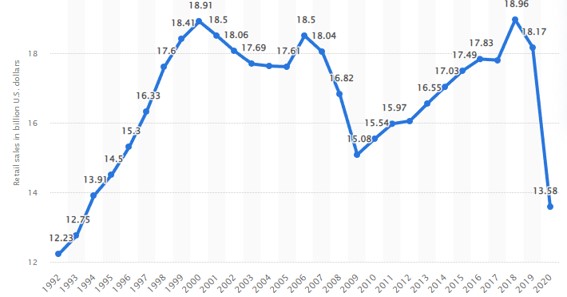Sometimes even small amounts make a big difference. Moreover, everyone also enjoys receiving prizes for their purchases. Banks employ these incentives to entice you to conduct business with them since they are aware of this. One of the freshest examples is the upcoming U.S. Bank Shopper Rewards, which is also known as Visa Signature Card. It offers up to 6% cash-back at numerous well-known businesses.
The card is not necessarily a good option for everyone, notwithstanding its eye-catching perks rate and that bewildering array of household name brands. This is especially true in the context that many of the businesses on its 6% list already can provide store credit cards that obtain up to 5% back with much less work and for no annual fee.
Yes, people who shop strategically—those who spend a lot of money annually at eligible retailers and aren’t afraid to put in a little extra effort to get the most out of their purchases—can make a fantastic choice in the U.S. Bank Shopper Cash Rewards. However, if that shop is where you spend most of your daily money, it doesn’t necessarily follow that it’s a good replacement for a store credit card.
Click here – 5 Reasons To Choose Paramount For Your Commercial Roofing Needs
Consider the Yearly Cost
The U.S. Bank Shopper Cash Rewards requires an annual charge, which is $0 for the first year and afterward $95. This is different from the majority of shop credit cards or even generic cash-back credit cards. In order to calculate the total value of the card over the first year, you must deduct $95 from the overall amount of cash back you get each year. Perhaps you too had a situation where you took out a 500 dollar loan to cover unexpected expenses.
The Visa Signature Card’s sign-up bonus can significantly reduce that expense, but only in case you can meet the card’s spending requirements: After making $2,000 in qualifying purchases throughout the first four months of opening the account, receive a $250 incentive.
Take Into Account Spending Limits
Examining Visa Signature’s value proposition requires taking into account how cash back is gained as well as any restrictions on that earning. The 6% cash-back rate is subject to the following limitations.
It only applies to two stores, not the other 24. Each quarter, you must choose one of those two retailers. If not, you’ll only get 1.5% back. The combined quarterly earnings from your two retailers are capped at $1,500. You might reach that cap rather fast, based on the amount you spend at all those stores. In either case, the 6% category offers just $90 in cash back every 3 months or $360 annually.
The card likewise has a 3% “daily” rewards level, but it too has a $1,500 cap and quarterly activation criteria. (Optional purchases that are fairly inclusive but not all-inclusive of “daily” purchases include wholesale clubs, gas stations, EV charging stations, bills, and utilities.) Whatever the case, the most you can make from the 3% level in a quarter is $45, or $180 in a year. Most retail credit cards that offer rewards don’t have yearly or quarterly spending limits.
Click here – Othman El Ballouti Shares 7 Signs You’re An Entrepreneur
What about an Example?
To illustrate all that was said above, let us give you an example. Here, a common retail card, the Target REDcard Credit Card, is compared to the U.S. Bank Shopper Cash Rewards Visa Signature Card to show how to balance the advantages and disadvantages of both.
Let’s assume you choose the U.S. Bank Shopper Cash Rewards Card and choose Target to be one of your two 6%-back categories since you frequently buy at Target. If you perform this every three months and consistently spend the $1,500 limit at Target, then you’ll spend $6,000 there in a year and receive $360 in cash back. However, you would have to pay an annual fee after the first year, which would reduce your take-home pay to $265.
There is no annual charge for the Target REDcard Credit Card. It offers 5% off of the majority of Target purchases, whether made in-store or online, and there is no spending limit. According to the aforementioned example, spending the same $$6,000 per year at Target might save you $300 over the course of the year. You wouldn’t have to worry about an annual fee, and you wouldn’t have to divide your spending evenly throughout the four quarters to stay under caps.
Is There Any Breakeven Point?
The yearly charge and quarterly restrictions on the U.S. Bank card change the math even though 6% is more than 5%. You would have to spend $9,500 at Target annually to beat a store card without an annual fee and with a 5% rate with it, but that isn’t doable with the Visa Signature Card. Why? Due to the fact that only $1,500 in quarters spending qualifies for 6% back; afterward, you’ll only receive 1.5% back at Target and others.
Why Do Store Cards and Shopper Cash Rewards Make Sense?
Since we have already said so much on this topic, it would be great to back up this information with facts. Why do various cash rewards and store cards exist at all? If you look at the graph, you will be able to understand the reason. Only in 2019 Americans spent over 18 billion dollars on novelty, gifts, and souvenir stores. In 2020, sales decreased from more than 18 billion dollars to nearly 13.6 billion dollars. However, the figures are impressive, which makes us think we often underestimate the sums we spend on small things.

Conclusion
In general, both store cards and cash rewards are able to help customers to save money, but it is worth noting that the two methods have their differences. If you use the information provided in this article, then you can save more every day even on small purchases.

